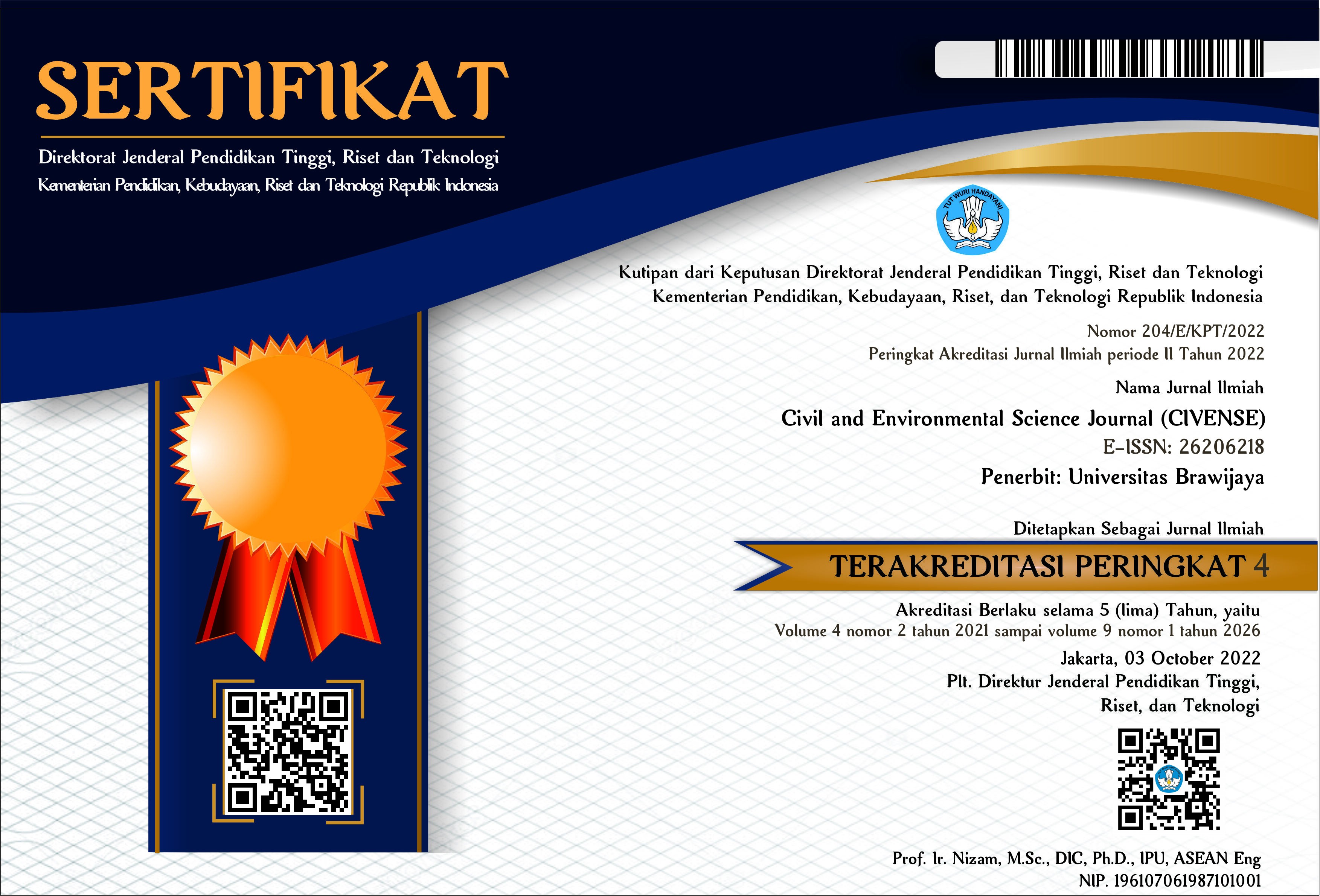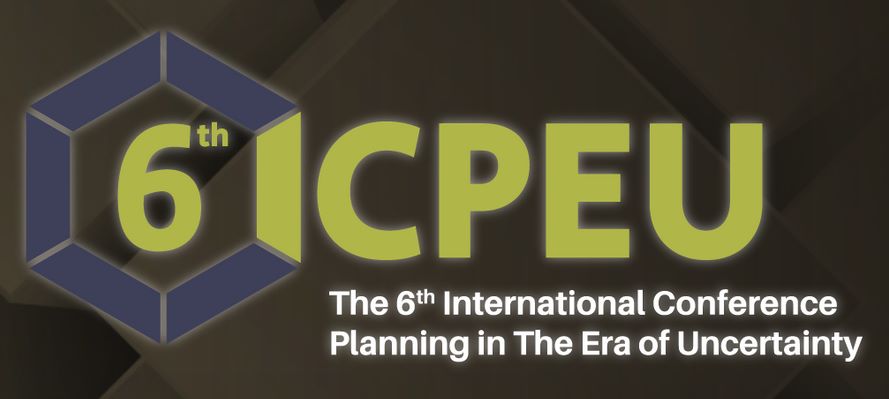Landslide Threat Analysis and Slope Reinforcement Method with Sheet Pile on Singaraja City Boundary Road – Mengwitani Km 37+900 Right
DOI:
https://doi.org/10.21776/ub.civense.2022.00502.8Keywords:
slope stability, safety factor, geostudio, steel sheet pile.Abstract
The trigger factor for landslides is due to high rainfall intensity and long duration and the drainage system on the slopes is not good, causing the soil to become saturated. The Singaraja–Mengwitani City road section every rainy season always occurs landslides due to the geometry of the road adjacent to the slope because it is in a hilly area, as well as a drainage system that does not function during the rainy season. Based on the results of the previous soil investigation, the road section is a type of silty clay due to weathering of the ancient Buyan-Beratan volcanic rocks. The research was conducted through a field investigation with 2 drill points in a depth of 30 m, and slope stability analysis with the help of Geoslope software obtained. The value of the existing slope safety factor was 0.939, while at the time of moderate rain for 6 hours it was obtained SF<0.332, this condition indicates that the slope will fail so that it needs to be strengthened. The reinforcement is carried out with steel sheet piles is 4.49 m with a total length of sheet piles used is 6.49 ~ 7 m, based on the results of the analysis after being given reinforcement of steel sheet piles the safety factor value is 1.674, while when it rains it is moderate for 6 hours at 1,210, the slope is declared stable/safe because SF>1.0.
References
I. N. Sinarta and I. W. Ariyana Basoka, "Safety factor analysis of landslides hazard as a result of rain condition infiltration on Buyan-Beratan Ancient Mountain Safety factor analysis of landslides hazard as a result of rain condition infiltration on Buyan-Beratan Ancient Mountain," J. Phys. Conf. Ser., vol. 1402, no. 2, 2019, doi: 10.1088/1742-6596/1402/2/022002.
I. N. Sinarta, "The Threat Level of Soil Movement in Volcanic Rocks in Bali Based on a Comprehensive Geotechnical Approach," Gadjah Mada University Yogyakarta, 2018.
I. G. Tejakusuma, P. Teknologi, S. Lahan, W. Dan, and M. Bencana, "Soil Water Content As Landslide Trigger At Girimekar Village Bandung West Java Province Landwater Content Triggers Landslide Girimekar Village Bandung Regency, West Java Province," J. Science and Technology. Indones., vol. 15, no. 1, pp. 34–41, 2013.
I. N. Sinarta, A. Rifa'i, T. F. Fathani, and W. Wilopo, "Spatial analysis of safety factors due to rain infiltration in the buyan-beratan ancient mountains," Int. Rev. Civ. Eng., vol. 11, no. 2, pp. 90–97, Mar. 2020, doi: 10.15866/IRECE. V11I2.17668.
I. N. Sinarta, "Negative Pore Stress as a Parameter of Soil Mechanics on Unsaturated Soil Slope stability," Paduraksa, vol. 5, pp. 31–42, 2016.
D. Safrina, M. Sungkar, and R. P. Munirwan, "Slope Stability Analysis With Bishop Method and Sheet Pile Reinforcement," J. Civ. Eng. Student, vol. 2, no. 3, pp. 309–315, 2020.
GEO-SLOPE International, "Seepage Modeling with SEEP/W 2007," Geostudio Help., no. February, p. 307, 2010.
K. P. Acharya, N. P. Bhandary, R. K. Dahal, and R. Yatabe, "Seepage and slope stability modelling of rainfall-induced slope failures in topographic hollows," Geomatics, Nat. Hazards Risk, vol. 7, no. 2, pp. 721–746, 2016, doi: 10.1080/19475705.2014.954150.
H. Darjanto, H. Farichah, and R. Lumintang, "Slope Stability Analysis and Alternatives to Handling Cladding Case Study of Ir. H. Nursyirwan Ismail Road Section, Samarinda City," J. Apl. Tech. Civil, vol. 19, no. 3, p. 215, 2021, doi: 10.12962/j2579-891x.v19i3.8495.
E. B. P. Hendra Sugih Arjaya and M. I. Ir Siti Hardiyati SP1.MT, Ir Indrastono DA, "Strengthening The Slopes At The Sutt Sta 19 +255 Toll Road Semarang – Solo Section Tinalun – Lemah Ireng," pp. 1–13.
J. Bowles, Physical and Geotechnical Properties Of Soil, 2nd ed. Chicago: McGraw-Hill Company, 1984.
Downloads
Published
How to Cite
Issue
Section
License
Copyright (c) 2022 I Made Adi Wirasana, I Nengah Sinarta, Ni Komang Armaeni

This work is licensed under a Creative Commons Attribution-NonCommercial 4.0 International License.
Authors who publish with this journal agree to the following terms:
Authors retain copyright and grant the journal right of first publication with the work simultaneously licensed under a Attribution-NonCommercial 4.0 International License that allows others to share the work with an acknowledgement of the work's authorship and initial publication in this journal.
Authors are able to enter into separate, additional contractual arrangements for the non-exclusive distribution of the journal's published version of the work (e.g., post it to an institutional repository or publish it in a book), with an acknowledgement of its initial publication in this journal.
Authors are permitted and encouraged to post their work online (e.g., in institutional repositories or on their website) prior to and during the submission process, as it can lead to productive exchanges, as well as earlier and greater citation of published work (See the Effect of Open Access).














